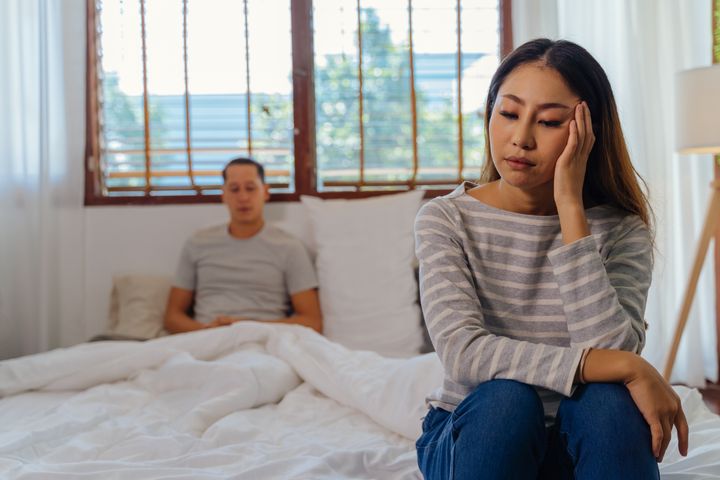
Mind-blowing. Addictive. Unforgettable. This is what I anticipated sex would feel like.
Bloody. Stabbing. Blunt. Burning. Unpredictable. Adjectives fail to emulate the entirety of how it felt.
Despite feeling utterly at ease and safe with my partner, it felt like erratic knife jabs to some internal concrete wall coupled with a tight burning sensation – and lots of blood.
I had seemingly no reason to experience this type of pain in my early twenties.
This physical pain became a regular occurrence; but the psychological toll hurt the most. Inadequacy. Guilt. Frustration. Hopelessness.
I was at a loss with what my body was attempting to communicate. With each failed touch of intimacy, I conjured up the idea that my partner was a step closer to walking away from our relationship. I felt increasingly distant from him.
Sex would typically end with me in my partner’s arms in tears, his attentive, loving consolations and patience doing little to reassure my stubborn self-criticism and spiralling confidence.
I felt a numbing anger and an aching desperation for not being able to enjoy the one activity that had a seemingly universal stamp of guaranteed pleasure - especially for young people. I never told my friends, the cloud of shame hanging over me too overbearing to break through.
I finally admitted to myself that the pain was, indeed, not normal when my symptoms persisted, and I felt increasingly alienated from my body. When I looked them up, I panicked, thinking I had cervical cancer, PCOS, an STI, or another disease. I booked an appointment with my gynaecologist.
I remember her puzzled expression as she looked over the inconclusive ultrasound scans. She booked me with a pelvic floor therapist who examined my weak vaginal muscles and remarked, “you poor thing”, before explaining that pelvic floor dysfunction was the culprit for my pain and bleeding.
I gave the diagnosis a quizzical stare, equally livid with my embarrassing unfamiliarity with it as I was relieved from the validation of my frustrations. She assured me that what I was experiencing matched the pain her other patients felt, admitting that it is a problem not often talked about.
After a quick psychological evaluation, it was concluded that my natural tendency to overthink and obsession with hustle culture contributed to my tension, that my hips and pelvis were likely retaining some traces of trauma (the extent of which I’m still unpacking), among other likelihoods.
I was then given some exercises designed to target and strengthen the trigger points in my weak pelvic floor muscles, a list of yoga positions that would alleviate the pain and instructed to meditate twice a day. Since adopting this holistic therapeutic approach, the pain has substantially subsided.
The validation was overwhelming – but I nevertheless felt a mythical cloud surrounding the potential causes, like that moment after you wake up from an unexpected nap not wondering where you are or how you got there.
And I’m far from alone in experiencing this.
1 in 3 women will encounter a pelvic floor disorder in her lifetime. And in a survey of 2,000 UK women for a study conducted by Opinium for the RCOG, half of those experiencing pelvic floor dysfunction symptoms never sought professional help; with 39% of them believing they were normal, and 21% avoiding help out of embarrassment.
“Pelvic floor dysfunction is a generalised term for any kind of problem that happens with that muscle group,” says Stephanie Rutherford, a licensed physical therapist specialising in pelvic health at Advanced Women’s Healthcare clinic in Bloomington, Illinois. She noted that burning, sharpness, a dull ache, and bleeding from tissue friction are all sensations during sex indicative of pelvic floor dysfunction.
Most of the online resources I later researched surrounding this condition pertained to only women who were experiencing postpartum or menopause – neither of which applied to me, only adding to the solitude of it all.
Maria Elliott is the founder of Maria Elliott Physiotherapy Services - one of the leading UK-based pelvic health clinics. She said there are several potential causes of pelvic floor dysfunction – from growing up with family trauma to falling on your tailbone.
Addressing the detrimental effects refraining from partnered sex can have on one’s mental health is crucial. Elliott said that once someone stops an activity from which they derive pleasure and reward, they get less dopamine and adrenaline, creating an anxiety that fuels low grade inflammation – both of which I was all too familiar with.
“I’m conscious of every move during intercourse. What if I lay in a certain degree and it will start again?”
This discussion unearthed a trove of new information for me to process regarding my own dysfunction – such as how the inflammation from my chronic kidney disease directly correlates to the tissues in my pelvic area.
This realisation process could be lonesome – however, that feeling quickly subsided when I found a community of other young women with similar experiences.
Soon after Poppy*, 24, started having sex, a one-night stand abruptly ended in her feeling a wall inside her hit with a “dull object”, as though her vagina had clenching teeth, and lots of blood. “I stand up, and it splatters like a fountain.” Her gynaecologist’s initial advice after her inconclusive ultrasound was to just have sex again.
Eventually she was told the problem was her pelvic floor, about which Poppy knew “literally nothing” as “I didn’t give birth, I’m only 20 years old...why?”. Sex for Poppy remains wrought with fear and uncertainty: “I’m conscious of every move during intercourse. What if I lay in a certain degree and it will start again?”.
Yaz Neri, 24, began experiencing similar dull and sharp pains with intercourse but remains unsure of the cause. Her uterus is retroverted, and the only advice given to her was that the pain will subside only after she gives birth – something she is not planning on doing anytime soon.
Rutherford said that pelvic floor dysfunction can “make or break a relationship”, tearing people down when they “can’t physically connect”. This is a sentiment experienced by Yaz when she began pondering asexuality and questioned her feelings towards her boyfriend: “I’m never the one initiating it. I always just feel like I want to do it just because of him.”

She detailed the exhaustive mental preparation women must go through to enjoy sex: “Even if I try now and if it doesn’t hurt, I will still have this mental block. I’ve actually been thinking about starting therapy for this.”
Bella, 30*, has Genito-Pelvic Dysesthesia and has experienced pelvic pain for over 20 years, with symptoms starting many years before she had sex: “I have deep pain with penetration and constant pain in my vulva, labia, perineum, and clitoris.”
She both craves and fears intercourse. For her, sexual release arrives only through partnered sex - a fact she finds “very disempowering”.
“I have worked with trauma therapists and sex therapists to find a place where I can accept this is what my body is doing,” Bella said.
From sadness, anger, and confusion to “dissociation and disembodiment”, the condition has brought her “mental suffering and torture”.
Prior to my own diagnosis (and ongoing recovery) of pelvic floor dysfunction, I was oblivious to the connection it had with my mental health.
Advocating for the importance of “mapping out a recovery roadmap which involves a multidisciplinary team,” Elliott notes that meditation plays a key role in releasing pelvic floor tension: “Down regulating and calming the autonomic nervous system through breathwork, releasing the jaw, diaphragm, and pelvic floor are all hugely beneficial.”
There is no one-and-done solution to, or cause of, pelvic floor pain. At 23 years old, I’m still investigating how my mind and body work in unison to affect my pelvic floor - which has also made my relationship with my partner stronger since we prioritise communication much more than we already had been.
Painful intercourse for women, particularly younger women not in menopause or postpartum, is a quiet uphill battle to better understand not just our bodies but crucially our psyches as well.
Poppy puts it well: “Fight for your right to avoid medical negligence till the very f*****g end.”